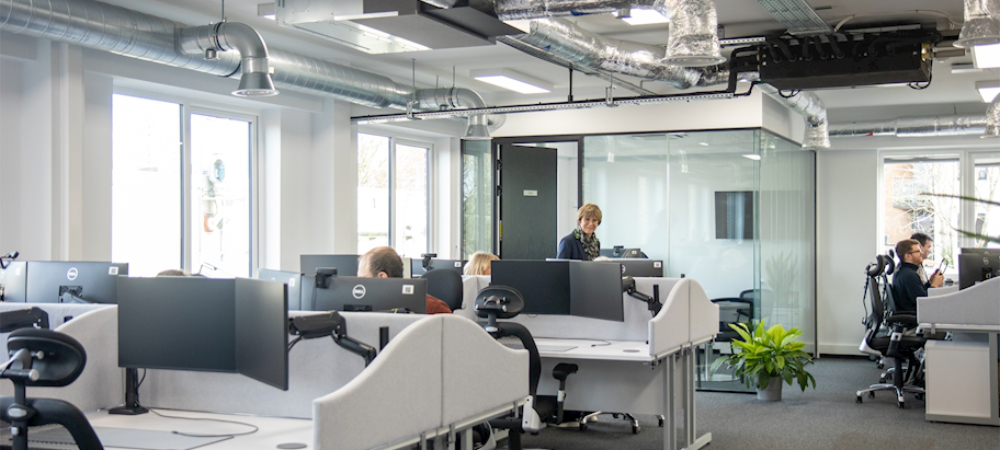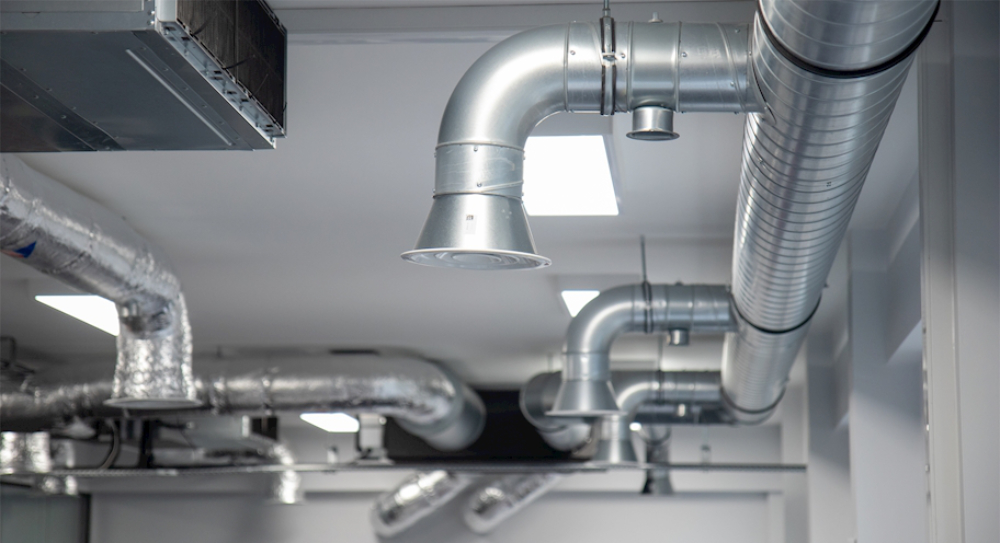BSRIA Living Laboratory phase 1 complete
[edit] A New Year, a new look for BSRIA with phase 1 complete
In January 2025, BSRIA wrote: "As we enter a new year, BSRIA is proud to reveal the completion of Phase 1 of our newly retrofitted state-of-the-art offices at BSRIA House in Bracknell. This milestone demonstrates what is possible with existing building stock, showcasing how retrofitting can drive sustainability and create spaces that reflect both innovation and environmental responsibility."
"Now fully decoupled from natural gas for space heating and hot water, the installation of a high efficiency low global warming potential (GWP) HVAC system will enhance indoor environmental quality and reduce energy consumption. Scope 1 and 2 greenhouse gas emissions in 2025 are forecast to be 28% lower when compared with our 2022 baseline."
"Our building performance experts meticulously measured the “as-built” performance of the building prior to the commencement of works, enabling informed data-driven decisions to maximise the effectiveness of retrofit measures and financial investment. As part of our ‘Living Laboratory’ project, we’re monitoring in-use performance metrics to evaluate systems and user behaviour, which will further drive continuous whole-building performance optimisation."
"The outputs of the office retrofit and the Living Laboratory will shortly serve as a live case study on the BSRIA website, providing real-world insights for others looking to make similar transitions."
"As we continue with subsequent retrofit phases, expect even more exciting updates as we shape a more sustainable, healthier future for our organisation."
[edit] Background to the Living Laboratory Innovation Challenge
In March 2024 with the launch of the BSRIA Living Laboratory Innovation Challenge, there was an exciting and unique opportunity for stakeholders to collaborate on the design, installation, and commissioning of a cutting-edge HVAC and lighting solution in the office space at the BSRIA Headquarters located in Bracknell, Berkshire.
The Challenge aimed to inspire creativity, drive innovation, and contribute to the development of sustainable HVAC and lighting solutions that can positively impact workplaces and the environment. The Challenge aligned with the vision of creating a greener, smarter, and more comfortable future for occupants in office spaces. Real-time in-use monitoring to be carried out on the performance of the HVAC and lighting solution and the indoor environment to demonstrate energy efficiency and occupant satisfaction.
The building constructed in the 1980s the concerns the first and second floors (each floor approximately measuring 17m x 14m x 2.75m) of a three-storey brick building, made of steel and concrete with screeded concrete slabs for floors and a concrete slab roof with an asphalt top layer. The building has single-glazed aluminium windows and had gas central heating with radiators. Incorporated within the three-storey building is a central stairwell, with welfare facilities on the first floor. In advance of the project and adopting a fabric first approach, BSRIA has embarked on multiple fabric performance improvements to the building. Pre and post air permeability, thermographic, heat loss, U-value, ambient noise level, and acoustic quality measurement surveys will be carried out by BSRIA and supplied to bidders to support phase 4 submissions.
The first section of this article appears on the BSRIA news and blog site as "New Year, new look for BSRIA" dated January 2025, the second section of this article is based on the "BSRIA Living Laboratory Innovation Challenge" published in March 2024.
--BSRIA
[edit] Related articles on Designing Buildings
- Atlas building, Eindhoven University.
- Air pollution index.
- At a glance - Indoor air quality.
- Briefing notes from BSRIA Sustainable Futures. Redefining Retrofit for Net Zero Living 2024.
- Bringing a breath of fresh air to the design of indoor environments.
- BSRIA Briefing 2023. Cleaner Air, Better Tomorrow
- BSRIA Briefing 2024: Sustainable Futures. Redefining Retrofit for Net Zero Living.
- Coronavirus and force majeure.
- COVID-19 and mental health within construction firms.
- Ensuring good indoor air quality in buildings.
- Health effects of indoor air quality on children and young people.
- IMMUNE Building Standard.
- Indoor air quality.
- Indoor environmental quality.
- Key takeaways from the BSRIA Briefing 2024.
- Open Innovation programme.
- Post occupancy evaluation of completed construction works.
- Soft landings.
- User experience UX.
- United Nations Economic Commission for Europe UNECE.
Featured articles and news
Gregor Harvie argues that AI is state-sanctioned theft of IP.
Many resources for visitors aswell as new features for members.
Using technology to empower communities
The Community data platform; capturing the DNA of a place and fostering participation, for better design.
Heat pump and wind turbine sound calculations for PDRs
MCS publish updated sound calculation standards for permitted development installations.
Homes England creates largest housing-led site in the North
Successful, 34 hectare land acquisition with the residential allocation now completed.
Scottish apprenticeship training proposals
General support although better accountability and transparency is sought.
The history of building regulations
A story of belated action in response to crisis.
Moisture, fire safety and emerging trends in living walls
How wet is your wall?
Current policy explained and newly published consultation by the UK and Welsh Governments.
British architecture 1919–39. Book review.
Conservation of listed prefabs in Moseley.
Energy industry calls for urgent reform.
Heritage staff wellbeing at work survey.
A five minute introduction.
50th Golden anniversary ECA Edmundson apprentice award
Showcasing the very best electrotechnical and engineering services for half a century.
Welsh government consults on HRBs and reg changes
Seeking feedback on a new regulatory regime and a broad range of issues.
CIOB Client Guide (2nd edition) March 2025
Free download covering statutory dutyholder roles under the Building Safety Act and much more.





























